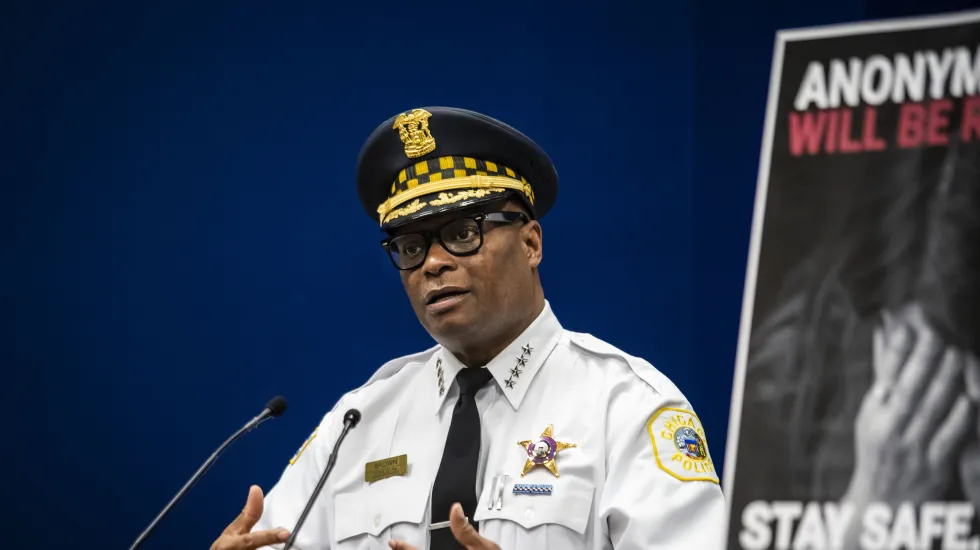
After a weekend that saw multiple shootings in Chicago’s downtown districts, Police Supt. David Brown on Monday noted a “displacement effect” this spring as crime rose in some areas of the city, while a handful of areas targeted by police and anti-violence programs have seen steep declines in shootings and murders.
At a news conference at police headquarters, Brown pledged to devote more resources to Chicago’s downtown and onto the CTA in response to increasing crime. But the superintendent, whose tenure has coincided with the COVID-19 pandemic and a citywide spike in violence, also pointed out that the 55 neighborhoods that have been the focus of the enhanced crime-fighting strategies have seen murders drop nearly 30% and shootings fall by more than 40%.
“That is a new dynamic, where we see decreases in areas that normally have both the volume and an increases in violence, and increases where we normally don’t have that kind of increase,” Brown said, noting that the mixed results across the city is a change from citywide surge in violence of the past two years. “If you look at last year, you see increases everywhere, whereas this year, for the first four months at least, you’re seeing decreases in some areas.”
Brown addressed reporters after a weekend that saw several shootings downtown, including a shooting during a robbery at a Taco Bell that left two men wounded. That night’s performance of “Moulin Rouge” at the nearby Nederlander Theatre was later canceled. Another shooting inside a Streeterville hotel early Sunday left an 18-year-old man dead, and a shooting early Saturday at a bowling alley on State Street left one woman dead and another wounded.
The numbers of shootings so far in the two police districts that cover downtown and the tony adjacent neighborhoods have increased from 14 during the first four months of 2021 to 23 so far this year, an increase of 75%. But in the city’s two most violent police districts, the 11th District on the West Side and the 6th on the South Side, there have been 75 fewer shootings, a decline of 65% from the same period in 2021.
Across the city, 35 people were shot over the weekend, nine of them fatally. Brown bristled when asked if the department would assign more officers to downtown after the wave of incidents in the city’s hub for tourism.
“I don’t want to separate downtown part from other neighborhoods,” he said. “The neighborhood is like any other neighborhood in the city.”
Citywide crime statistics show murders are down 9% in comparison to the first four months of 2021, and 15% from the previous April. But total crime was up more than a third from 2021 levels, with a 66% increase in theft and a 36% jump in burglaries. In Chicago and other cities across the U.S., property crimes had declined steeply during the pandemic, while shootings and murders surged to levels not seen since the 1990s.
Crime had also dropped on the CTA in 2020 and last year, as fewer commuters boarded trains and buses during the pandemic. But assaults and theft on the CTA have increased in recent months, though ridership still has not returned to pre-pandemic levels.
Carjackings also continued to rise so far this year, with the number of incidents up 6% compared to the same period in 2021— the highest total in 20 years, and another statistic that is on par with increases in other U.S. cities during the pandemic.
Brown said the department this week would begin deploying “additional resources” to police districts across the city and would increase coordination with unarmed security officers that patrol the CTA. In some cases, that will require pulling officers off desk jobs to put them on the streets.
“It’s looking at not just Patrol Bureau to deploy resources, it is looking at all of our police bureaus and deploying officers that maybe have not traditionally worked in the field, in a neighborhood,” Brown said. “Those (officers) that may work behind a desk (will be) spending some time in patrol as part of a deployment strategy.”
Brown attributed the surge in carjackings to “teen and pre-teen” offenders, noting that youths comprised the majority of those arrested for carjacking and that many of them accumulate multiple arrests. Brown said that the department would continue to stack charges on those arrested but also noted that young offenders have reformed when connected with support. Researchers at University of Chicago and Northwestern University have questioned whether young offenders are behind the spike in carjackings.
But in the longest section of his remarks, Brown recounted the example of an 11-year-old carjacking suspect, who had not been in school for two years when he was arrested and found to have 20 car key fobs in his room. After a year of intensive mentoring through the “Choose to Change” program, the boy had not missed a day of school, earned a place on the honor roll and had not committed another carjacking.
“The capacity to change the behavior of our young people does include the arrest the charge, but it also includes providing services to change their behavior,” he said. “It is the arrest, the charge and social services too.”







